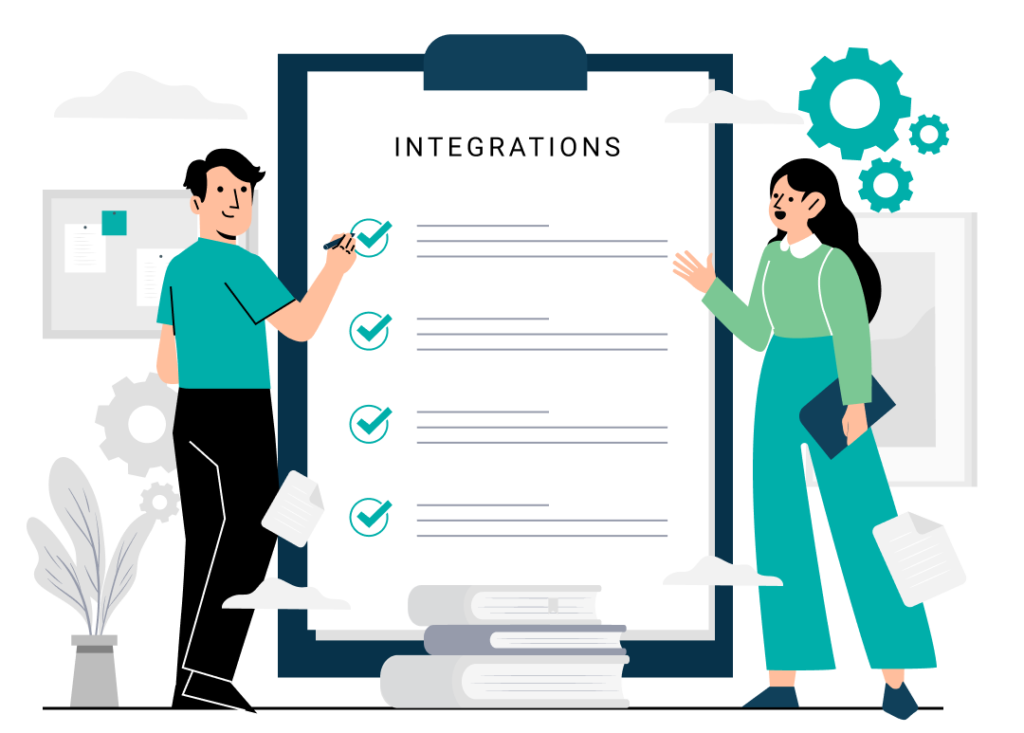Your business is built on software and software is expensive to build because it is hard to build. You’re an SME so allocating your limited resources strategically is essential. This article will cover how to assess your current resources and capabilities, identify the best areas for innovation and ROI, and allocate resources to support your strategic growth initiatives.
It’s a complex process, so we’re going to give a quick overview of the strategies and decision-making involved so you know where to start and what you should be looking for.
Conferensity: Our example for resource allocation
To illustrate resource allocation we’re going to use the same imaginary company we use in all the articles in this series – Conferensity. They’re a B2B event management platform with aspirations to become a comprehensive conference solution.
Their strategy involves expanding their web-based software’s capabilities and developing two apps – one for conference admins and another for attendees.
While these are three digital products, 1 website and 2 apps, there is actually a fourth project – the updated backend that will implement the features the website and apps will provide interfaces for. This backend will also require extensive work to provide all the necessary admin features to manage the new frontend features. By dedicating their resources to these four digital projects Conferensity is actively working towards achieving their primary business objective.
Here is some of what they want their products to do:
- manage venue communication and arrangements (such as contracts, venue layout, and extra services like conference Wi-Fi, local tours, etc)
- handle communication with speakers, panel members, and guests (including contracts, accommodation, presentation reservations, and travel), and
- provide opportunities to make purchases through the app for everything from refreshments to accommodation and perhaps one day flights.
Their first app will be for conference admins, duplicating the client-accessible website’s functionality. The second app, designed for attendees, will allow attendees to reserve seats, purchase tickets to the conference, and pay for any related services, purchase refreshments and merchandise. It will also have features like schedules and venue maps, presentation start reminders, live questions via chat rooms, presentation feedback, and special features for speakers.
Their strategy encompasses a website overhaul and the launch of two apps supported by a robust back-end system. The success of these digital projects is critical to achieving their goal of increased market share and revenue.
Assessing Your Current Resources and Capabilities
A comprehensive evaluation of your resources is essential for effective strategic planning. This assessment provides a clear understanding of your strengths, weaknesses, and areas for improvement, enabling you to make informed decisions about resource allocation and project prioritisation.
There are a lot of resource areas you can look at. But we think the five below are the ones that are going to really make or break your plans. By carefully examining the following five key resource areas, you can ensure that your project goals are in line with your capabilities:
- Financial Resources: Deep dive on your budget for each new project. Assess cash flow, investment capacity, and funding options to ensure financial viability.
- Technological Assets: Evaluate your current tech stack. Can your existing software and hardware accommodate the planned digital products, or are upgrades necessary? Do you have the expertise for those upgrades? The budget?
- Human Capital: Assess the skills and expertise of your team. Do you have the necessary talent in-house, or is there a need for recruitment or staff augmentation?
- Operational Capabilities: Review your development and deployment processes. Are they agile enough to adapt to the iterative nature of digital product development?
- Market Position: Analyse your market standing. How can your brand and customer base be leveraged to promote and support new digital offerings?
While these are the primary resources, you should also consider other assets such as data, intellectual property, and strategic partnerships, tailoring the focus to your specific business context.
Identifying Areas with the Highest Potential for Growth and ROI
To identify areas for growth, you need to conduct an analysis of market trends, customer needs, the competitive landscape, and your own internal capabilities. This assessment provides insights to pinpoint opportunities that can drive growth.
The process begins with market research to understand emerging industry trends and identify customer needs. By engaging with customers through surveys, feedback mechanisms, and user testing, you can gain insights into their experiences and expectations.
This customer-centric approach is essential for uncovering opportunities to enhance the product or service offering in meaningful ways. Equally important is benchmarking against competitors to identify areas where your business can differentiate and capture a larger share of the market.
Analysing the competitive landscape reveals gaps in the current solutions, allowing you to strategically position your innovations to stand out and appeal to target customers.
In parallel, you must assess your own internal capabilities, evaluating the technological feasibility of potential innovations. This involves conducting technical studies to ensure the planned developments can be realistically achieved with the available resources and expertise.
Financial projections are then used to estimate the potential return on investment, considering the costs of development, marketing, and sales efforts.
By taking this comprehensive approach, you can identify the most promising areas for innovation – those that are not only desirable from a market perspective, but also viable and financially sound for you to pursue.
This strategic alignment between market needs, competitive positioning, and internal capabilities is crucial for maximising the impact and return on innovation investments.
How Conferensity Identified Directions for Growth
Conferensity, a B2B event management platform, provides a good example of how to identify areas for innovation that can deliver ROI. Let’s break down their process:
- Market Analysis: Conferensity conducted a thorough market analysis, identifying a gap in comprehensive digital solutions for event management. They recognised the need for a unified platform that could handle complex tasks such as venue arrangements and speaker communications.
- Customer Feedback: By analysing feedback, Conferensity pinpointed the need for a mobile attendee app that could enhance the event experience through features like live questions and presentation feedback.
- Competitive Benchmarking: They assessed the competitive landscape and found that integrating in-app purchases for event-related services could be a significant differentiator.
- Technological Feasibility: The team evaluated their tech stack and determined that developing two distinct apps, supported by a robust backend, was within their capabilities.
- Financial Projections: Conferensity projected the revenue potential of the new features, considering transaction fees and increased market share, to ensure a positive ROI.
Allocating Resources Effectively to Support Strategic Growth Initiatives
When allocating resources, you need to make strategic decisions to ensure each investment supports the company’s growth goals and maximizes ROI. Let’s look at the decisions Conferensity made and the reasoning behind them. This can serve as a guide for other SMEs allocating their resources.
Development Focus
Conferensity recognised that the attendee app was a critical touchpoint for user engagement and revenue generation. They decided to allocate their most skilled developers to this project, ensuring that the app’s user experience and functionality would be of the highest quality.
This focus on development resources was based on the understanding that a superior attendee app could significantly enhance the overall event experience, leading to increased user retention and higher transaction volumes.
Extended Software Development Team
To efficiently progress with their backend development, Conferensity opted for staff augmentation by partnering with a near-shore team extension provider. This strategy allowed them to extend their software development team with experienced professionals who could handle the standard backend features. The benefits of this approach included cost savings compared to hiring full-time staff, access to a broader skill set, and the ability to scale the team up or down as needed. This flexible staffing solution enabled Conferensity to maintain focus on their core competencies while ensuring timely and efficient progress on their backend infrastructure.
Infrastructure Investment
Investing in cloud infrastructure was a strategic move for Conferensity to support the scalability and reliability of their expanded platform. They understood that as their user base grew, the demand on their system would increase. By choosing a scalable cloud solution, they ensured that their platform could handle this growth without compromising performance, thus providing a seamless experience for their users and maintaining a high level of customer satisfaction.
Marketing and Sales Alignment
Conferensity allocated a significant portion of their resources to the marketing and sales efforts for the new apps. They targeted high-profile events to generate buzz and early adoption, understanding that these events would provide the visibility needed to attract more users. The alignment of marketing and sales efforts was crucial to ensure that the message about the new apps reached the right audience at the right time, ultimately driving adoption and revenue.
Agile Resource Management
Adopting agile practices allowed Conferensity to manage their resources with flexibility. They could swiftly reallocate resources in response to feedback and market demands, ensuring that their projects remained on track and aligned with user needs. This approach to resource management was instrumental in allowing Conferensity to adapt to changes quickly, whether in response to user feedback or shifts in the market landscape.
Summing it all up
The allocation of resources for web and app development is an important task for you when pursuing innovation and market share. By evaluating your current resources and capabilities, identifying areas with potential for growth and ROI, and making decisions about resource allocation, you can support your growth initiatives. This approach ensures that each investment is aligned with your company’s objectives, utilising resources and positioning your business for success in the digital landscape.












